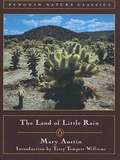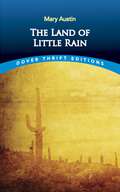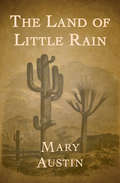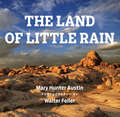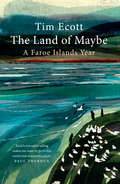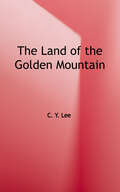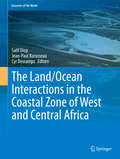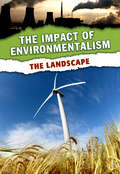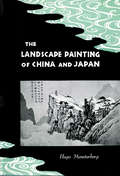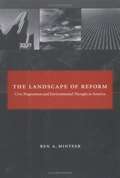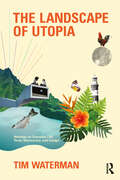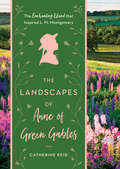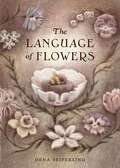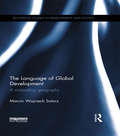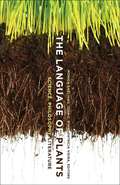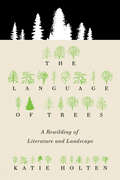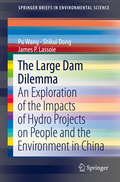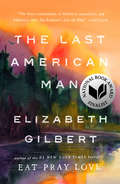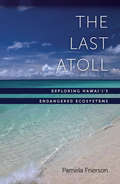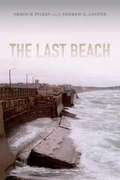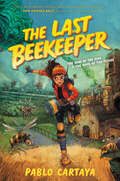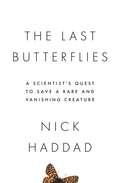- Table View
- List View
The Land of Little Rain
by Mary Austin Terry Tempest WilliamsI confess to a great liking for the Indian fashion of name-giving: every man known by that phrase which best expresses him to whoso names him. Thus he may be Mighty-Hunter, or Man-Afraid-of-a-Bear, accor-ding as he is called by friend or enemy, and Scar-Face to those who knew him by the eye's grasp only. No other fashion, I think, sets so well with the various natures that inhabit in us, and if you agree with me you will understand why so few names are written here as they appear in the geography. For if I love a lake known by the name of the man who discovered it, which endears itself by reason of the close-locked pines it nourishes about its borders, you may look in my account to find it so described. But if the Indians have been there before me, you shall have their name, which is always beautifully fit and does not originate in the poor human desire for perpetuity. Nevertheless there are certain peaks, cañons, and clear meadow spaces which are above all compassing of words, and have a certain fame as of the nobly great to whom we give no familiar names. Guided by these you may reach my country and find or not find, according as it lieth in you, much that is set down here. And more. The earth is no wanton to give up all her best to every comer, but keeps a sweet, separate intimacy for each.
The Land of Little Rain (Dover Thrift Editions: Nature/Environment)
by Mary AustinThe enduring appeal of the desert is strikingly portrayed in this poetic study, which has become a classic of the American Southwest. First published in 1903, it is the work of Mary Austin (1868-1934), a prolific novelist, poet, critic, and playwright, who was also an ardent early feminist and champion of Indians and Spanish-Americans. She is best known today for this enchanting paean to the vast, arid, yet remarkably beautiful lands that lie east of the Sierra Nevadas, stretching south from Yosemite through Death Valley to the Mojave Desert.Comprising fourteen sketches, the book describes plants, animals, mountains, birds, skies, Indians, prospectors, towns, and other aspects of the desert in serene, beautifully modulated prose that conveys the timeless cycles of life and death in a harsh land. Readers will never again think of the desert as a lifeless, barren environment but rather as a place of rare, austere beauty, rich in plant and animal life, weaving a lasting spell over its human inhabitants.
The Land of Little Rain (Zia Book Ser.)
by Mary AustinA stirring tribute to the unique beauty of theAmerican Southwest In the region stretching from the High Sierras south of Yosemite to the Mojave Desert, water is scarce and empty riverbeds hint at a lush landscape that has long since vanished. But the desert is far from lifeless. For those who know where to look, the &“land of little rain&” is awash in wonders. In this exquisite meditation on the people, flora, and fauna of the American desert, Mary Austin introduces readers to the secret treasures of the landscape she loved above all others. Her lyrical essays profoundly influenced the work of nature writers and conservationists, among them Edward Abbey and Terry Tempest Williams, and have inspired generations of readers to visit some of the country&’s most stunning national parks, including Death Valley and Joshua Tree. This ebook has been professionally proofread to ensure accuracy and readability on all devices.
The Land of Little Rain: With photographs by Walter Feller (Mint Editions Ser.)
by Mary Hunter AustinMary Austin's Land of Little Rain, first published in 1903, is considered by many to be one of the foundational texts in environmental writing, now studied as a classic in the literature that sought to describe the complexity of the American continent. Like John Muir, who wrote so intimately of the High Sierra that vast acreages have been preserved through the knowledge he shared, the work of Mary Austin has allowed those who will never travel there a deep feeling for the special beauties of the Southwest. Her poetic sensibility expressed in an inimitable prose paint a timeless portrait of that vast dry expanse, the Mojave northward from the Mexican border to Death Valley, with the Eastern Sierra to the west and the Colorado River to the east.This new large format edition includes all of the original text together with the intimate color work of noted photographer Walter Feller, a lifelong admirer of Austin's writing. He has spent years photographing the American Southwest, bringing to life the region's vital landscape and wildlife in images of astonishing beauty.
The Land of Maybe: A Faroe Islands Year
by Tim EcottFollowing the natural cycle of the year, The Land of Maybe captures the essence of the 18 mysterious Faroe Islands in the North Atlantic. Here, a fast disappearing world is home to a close-knit society where just 50,000 people share Viking roots and a unique language. Buffeted by the elements in a volatile environment, the Faroese still hunt seabirds, herd pilot whales and eat mutton fermented in the salt winds that howl across dark fjords. A passionate naturalist, Ecott immerses himself in this starkly beautiful landscape, revealing a way of life that maintains a deep connection to the past. The Land of Maybe offers a refuge from the freneticism of the modern world, and confronts some of the biggest challenges we face in trying to live in peace with nature.
The Land of The Golden Mountain
by C. Y. LeeSeeking a better life, losing everything, and yet finding a way to carry on. The trip across the Pacific to land was so strange and yet somewhat familiar. A story of family, loss, determination, friendship, travel, seafaring, and a gold rush. Learning to adjust and hold on to traditions. Disguising yourself to survive and yet yearning to show the world what beauty you possess.
The Land/Ocean Interactions in the Coastal Zone of West and Central Africa
by Salif Diop Jean-Paul Barusseau Cyr DescampsAlthough the main focus of this book is on the estuaries, its scope goes well beyond this particular coastal feature. Indeed, the estuary can only be considered as part of the life cycle of the entire river and the marine area it feeds into: an area particularly subject to human and natural pressures. The main estuaries and deltas of West and Central Africa region provide a variety of goods and services to its coastal population. The most important of them are related to critical fish habitat, wood and charcoal from mangroves, as well as space for agriculture, aquaculture, urban development, tourism and transport. Particular emphasis has been made in this book on mangroves that play a significant role in terms of flood control, groundwater replenishment, coastline stabilization and protection against storms. They also retain sediments and nutrients, purify water, and provide critical carbon storage. Such hydrological and ecological functions explain the focus on serving mangrove ecosystems and the nearby communities, which draw significant income from fishing, rice production, tourism, salt extraction and other activities such as harvesting honey and medicinal plants, hence the need for preserving mangrove ecosystems to ensure sustainability of the estuaries and deltas of West and Central Africa region. The book has a foreword by Mr. Achim Steiner, United Nations Under-Secretary General and Executive Director of UNEP who is stating that credible and up-to-date information is essential for the public at large but more specifically for scientists, researchers, managers, decision-makers all working together in order to safeguard, protect and sustainably manage estuaries, deltas and lagoons, and the coastal and ocean waters of Western and Central Africa.
The Landscape (The Impact of Environmentalism)
by Neil MorrisWe are all aware of the importance of the environment - it's in the news, it affects our behavior and the decisions we make every day. But what actual impact has environmental thinking had on the world around us? This thought-provoking book looks at the way changing ideas about the environment and sustainability have affected our attitudes to the landscape, and will do so in the future.
The Landscape Painting of China and Japan
by Hugo MunsterbergThe Landscape Painting of China and Japan presents for the first time in English a full and lucid account of the remarkable art form which, as a distinct tradition in Oriental art, has come to be universally recognized as one of the greatest in the world. <P><P>The author points out how essential it is to an understanding of the Orient when he says: "In China alone, landscape painting has religious as well as philosophical significance...and in consequence is one of the great manifestations of the human spirit, as well as the most remarkable creation of the Chinese artistic genius." And it was this same artistic tradition which, brought to Japan, was transmuted by the intense Japanese love of nature into paintings that "for sheer beauty of color and design have few equals," leading at last to the simplicity and grandeur of the uniquely Japanese woodblock print.Writing for scholar and layman alike, the author carefully traces the evolution of the art throughout its long history, discusses the major artistic personalities against their cultural backgrounds, and systematically describes the development and forms of the landscape. The text is thoroughly illustrated with over a hundred carefully selected plates and a colored frontispiece.
The Landscape of Reform: Civic Pragmatism and Environmental Thought in America
by Ben A. MinteerMinteer offers a fresh and provocative reading of the intellectual foundations of American environmentalism, focusing on the work and legacy of four important conservation and planning thinkers in the first half of the twentieth century.
The Landscape of Utopia: Writings on Everyday Life, Taste, Democracy, and Design
by Tim WatermanA collection of short interludes, think pieces, and critical essays on landscape, utopia, philosophy, culture, and food, all written in a highly original and engaging style by academic and theorist Tim Waterman. Exploring power and democracy, and their shaping of public space and public life, taste, etiquette, belief and ritual, and foodways in community and civic life, the book provides a much-needed critical approach to landscape imaginaries. It discusses landscape in its broadest sense, as a descriptor of the relationship between people and place that occurs everywhere on land, from cities to countryside, suburb to wilderness. With over fifty black and white illustrations interspersing the twenty-six chapters, this is a book for professionals, academics, and students to dive into and spark discussion on new modes of thinking in the wake of unfolding global crises, such as COVID-19, climate change, fascism 2.0, and beyond.
The Landscapes of Anne of Green Gables: The Enchanting Island that Inspired L. M. Montgomery
by Catherine Reid“This book will be treasured by Montgomery’s legions of fans.” —Carolyn Strom Collins, author of The Anne of Green Gables TreasuryThe Landscapes of Anne of Green Gables explores L. M. Montgomery’s deep connection to the landscapes of Prince Edward Island that inspired her to write the beloved Anne of Green Gables series. From the Lake of Shining Waters and the Haunted Wood to Lover’s Lane, you’ll be immersed in the real places immortalized in the novels. Using Montgomery’s journals, archives, and scrapbooks, Catherine Reid explores the many similarities between Montgomery and her unforgettable heroine, Anne Shirley. The lush package includes Montgomery’s hand-colorized photographs, the illustrations originally used in Anne of Green Gables, and contemporary and historical photography.
The Language of Flowers
by Dena SeiferlingAn adopted bumblebee learns the language of flowers from her floral family in this enchanting picture book, inspired by floriography, that celebrates one of nature's most important relationships.Deep within a magical meadow, some lonely flowers receive a very special gift: a baby bumblebee in need. The flowers name her Beatrice, they care for her and help her find her wings. And as she grows older, Beatrice learns the language of her floral family — messages of kindness and appreciation that she delivers between them. With each sweet word, the flowers bloom until the meadow becomes so big that Beatrice needs help delivering her messages and decides to set out in search of her own kind. But this little bee&’s quest takes her beyond the safety of the meadow and into the dangerous swamp the flowers have warned her about, a swamp inhabited by strange plants with snapping jaws and terrible teeth . . . will these prickly plants let her pass? Could they just be in need of a little sweetness themselves? A gently fanciful tale of the miracle of pollination and the important relationship between flowers and bees, this sweetly affirming story, inspired by the Victorian practice of floriography, suggests the secret to flourishing is kindness and appreciation.
The Language of Global Development: A Misleading Geography (Routledge Studies in Development and Society)
by Marcin Wojciech SolarzTerms such as "Third World", "developing countries" and "Global South" are ubiquitous in the discipline of development studies, but they are often poorly defined, ideologically weighted and misleading. Taking an intellectual history approach, this book examines the most commonly used spatial terms in the language of development, tracing their origins, meanings, evolution and processes of popularisation and demonstrating how geographical, political and economic concepts were used or misused in creating these terms. The book looks at the origins and the changing nature of fundamental development divisions from prehistoric times to the present day and analyses the process of conceptualising the contemporary North-South divide, focusing especially on the start of spatial development terminology in the twentieth century. It uses detailed maps to assist the reader in visualising the geographical complexities of these spatial terms, and discusses more recently developed terms, such as "emerging markets" and "BRIC", which are key to understanding the modern world. This book provides a valuable resource for students and researchers in development studies, international relations, geography, sociology and anthropology, as well as practitioners in the field of development.
The Language of Law and Food: Metaphors of Recipes and Rules (Juris Diversitas)
by Salvatore MancusoThis book reconsiders the use of food metaphors and the relationship between law and food in an interdisciplinary perspective to examine how food related topics can be used to describe or identify rules, norms, or prescriptions of all kinds. The links between law and food are as old as the concept of law. Many authors have been using such links in creative ways to express specific features of law. This is because the language of food and cooking offers legal thinkers and teachers mouth-watering metaphors, comparing rules to recipes, and their combination to culinary processes. This collection focuses on this relationship between law and food and takes us far beyond their mere interaction, to explore different ways of using these two apparently so diverse elements to describe different phenomena of the legal reality. The authors use the link between food and law to describe different aspects of the legal landscape in different areas and jurisdictions. Bringing together metaphors and indirect correlations between law and food, the book explores different models of approaching legal issues and considering different legal challenges from a completely new perspective, in line with the multidisciplinary approach that leads comparative legal studies today and, to a certain extent, revisiting and enriching it. With contributions in English and French, the book will be of interest to academics and researchers working in the areas of law and food, law and language, and comparative legal studies.
The Language of Plants: Science, Philosophy, Literature
by John C. Ryan Monica Gagliano Patrícia VieiraThe eighteenth-century naturalist Erasmus Darwin (grandfather of Charles) argued that plants are animate, living beings and attributed them sensation, movement, and a certain degree of mental activity, emphasizing the continuity between humankind and plant existence. Two centuries later, the understanding of plants as active and communicative organisms has reemerged in such diverse fields as plant neurobiology, philosophical posthumanism, and ecocriticism. The Language of Plants brings together groundbreaking essays from across the disciplines to foster a dialogue between the biological sciences and the humanities and to reconsider our relation to the vegetal world in new ethical and political terms.Viewing plants as sophisticated information-processing organisms with complex communication strategies (they can sense and respond to environmental cues and play an active role in their own survival and reproduction through chemical languages) radically transforms our notion of plants as unresponsive beings, ready to be instrumentally appropriated. By providing multifaceted understandings of plants, informed by the latest developments in evolutionary ecology, the philosophy of biology, and ecocritical theory, The Language of Plants promotes the freedom of imagination necessary for a new ecological awareness and more sustainable interactions with diverse life forms.Contributors: Joni Adamson, Arizona State U; Nancy E. Baker, Sarah Lawrence College; Karen L. F. Houle, U of Guelph; Luce Irigaray, Centre National de la Recherche Scientifique, Paris; Erin James, U of Idaho; Richard Karban, U of California at Davis; André Kessler, Cornell U; Isabel Kranz, U of Vienna; Michael Marder, U of the Basque Country (UPV-EHU); Timothy Morton, Rice U; Christian Nansen, U of California at Davis; Robert A. Raguso, Cornell U; Catriona Sandilands, York U.
The Language of Trees: A Rewilding Of Literature And Landscape
by Katie HoltenA LitHub Most Anticipated Book of 2023 “A masterpiece. Katie Holten's tree alphabet is a gift to the printed world.”—Max Porter, author of Grief is a Thing with Feathers Inspired by forests, trees, leaves, roots, and seeds, The Language of Trees: A Rewilding of Literature and Landscape invites readers to discover an unexpected and imaginative language to better read and write the natural world around us and reclaim our relationship with it. In this gorgeously illustrated and deeply thoughtful collection, Katie Holten gifts readers her tree alphabet and uses it to masterfully translate and illuminate beloved lost and new, original writing in praise of the natural world. With an introduction from Ross Gay, and featuring writings from over fifty contributors including Ursula K. Le Guin, Ada Limón, Robert Macfarlane, Zadie Smith, Radiohead, Aimee Nezhukumatathil, James Gleick, Elizabeth Kolbert, Plato, and Robin Wall Kimmerer, Holten illustrates each selection with an abiding love and reverence for the magic of trees. She guides readers on a journey from creation myths and cave paintings to the death of a 3,500-year-old cypress tree, from Tree Clocks in Mongolia and forest fragments in the Amazon to the language of fossil poetry, unearthing a new way to see the natural beauty all around us and an urgent reminder of what could happen if we allow it to slip away. The Language of Trees considers our relationship with literature and landscape, resulting in an astonishing fusion of storytelling and art and a deeply beautiful celebration of trees through the ages.
The Large Dam Dilemma
by Pu Wang Shikui Dong James P. LassoieLarge dam construction has significant environmental and social impacts at different scales. As the largest developing country in the world, China has built about half of the world's large dams, and more are expected to be built over the next two decades to meet the country's rapidly growing demand for energy. This book summarizes and updates information about the history, distribution, functions, and impacts of large dams, both globally and at China's national level. It then addresses the environmental and social-economic impacts of large dams in China with particular emphasis on the impacts of large dams on relocated people and associated compensation policies. Lastly, it introduces an integrated ecological and socio-economic study conducted in areas affected by dams along the Upper Mekong River, China. This book has the following three goals. The first goal is to summarize and update information on large dams globally and at China's national level (Ch. 2). We examine large dam problems from different perspectives, ranging from their spatial and temporal distributions and their environmental and social impacts, to discussions and debates centered on them. We also incorporate the results of an empirical investigation of the environmental and socio-economic impacts of large dams on the Upper Mekong River, China, and draw conclusions out of the analysis (Chs. 3 & 4). Our second goal is to provide an analysis framework to help understand the environmental and social-economic impacts of dam construction and the resulting environmental degradations and social inequities at different scales (Chs. 3 & 4), as well as to offer recommendations for mitigating these impacts within China's socio-political context (Ch. 5). The significant environmental effects resulting from dam construction include damage to ecological integrity and loss of biological diversity. The most significant social consequences brought by dam projects are their negative impacts on relocated people. Our analysis framework provides approaches to help comprehensively understand these impacts. Our third goal is to provide clues and suggestions for further studies of large dam problems both globally and in China (Ch. 5). The construction of large dams is proceeding rapidly in different parts of the world despite the heated debates on whether they should be built at all. The decision-making process related to building large dams involves considerations of economic viability, environmental sustainability, and social equity. Therefore, interdisciplinary collaborations are required in large dam research and development projects in order to reconcile the interests of different stakeholders and avoid harming ecosystems, biodiversity, and human welfare. Overall, we hope our book facilitates future examinations of large dams by providing summaries of existing data and research related to large dams, and offering a framework for better understanding and analyzing their environmental and social impacts.
The Last American Man
by Elizabeth Gilbert<P>In this rousing examination of contemporary American male identity, acclaimed author and journalist Elizabeth Gilbert explores the fascinating true story of Eustace Conway. <P>In 1977, at the age of seventeen, Conway left his family's comfortable suburban home to move to the Appalachian Mountains. <P>For more than two decades he has lived there, making fire with sticks, wearing skins from animals he has trapped, and trying to convince Americans to give up their materialistic lifestyles and return with him back to nature. <P>To Gilbert, Conway's mythical character challenges all our assumptions about what it is to be a modern man in America; he is a symbol of much we feel how our men should be, but rarely are. <P><b>Finalist for the National Book Award 2002</b>
The Last Atoll
by Pamela FriersonThe Last Atoll is a first-person account of journalist Pamela Frierson's ten-year exploration of the exotic and ecologically significant small lands at the far northwestern end of the Hawaiian island chain. Frierson takes readers on a rare journey to eight of these remote and ancient islands, including the Kure Atoll, the oldest Hawa'i'ian island and the northernmost atoll in the world. In her 1,200-mile travels, Frierson discovers isolated landscapes, undisturbed ecosystems, and a nearly forgotten but well-preserved human history. It is a rich history of discovery by explorers and pirates, plus extensive military use. Frierson finds a vast wilderness, including the remnants of ancient volcanoes, and unique species of wildlife. She also explores the islands' location in the Great Pacific Garbage Patch, a major current that washes up the world's garbage. A lifelong resident of Hawai'i, Frierson draws broad conclusions relating to islands and their "canary in a coal mine" role.
The Last Atoll
by Pamela FriersonThe Last Atoll is a first-person account of journalist Pamela Frierson's ten-year exploration of the exotic and ecologically significant small lands at the far northwestern end of the Hawaiian island chain. Frierson takes readers on a rare journey to eight of these remote and ancient islands, including the Kure Atoll, the oldest Hawa'i'ian island and the northernmost atoll in the world. In her 1,200-mile travels, Frierson discovers isolated landscapes, undisturbed ecosystems, and a nearly forgotten but well-preserved human history. It is a rich history of discovery by explorers and pirates, plus extensive military use. Frierson finds a vast wilderness, including the remnants of ancient volcanoes, and unique species of wildlife. She also explores the islands' location in the Great Pacific Garbage Patch, a major current that washes up the world's garbage. A lifelong resident of Hawai'i, Frierson draws broad conclusions relating to islands and their "canary in a coal mine" role.
The Last Beach
by Orrin H. Pilkey Jr. J. Andrew CooperThe Last Beach is an urgent call to save the world's beaches while there is still time. The geologists Orrin H. Pilkey and J. Andrew G. Cooper sound the alarm in this frank assessment of our current relationship with beaches and their grim future if we do not change the way we understand and treat our irreplaceable shores. Combining case studies and anecdotes from around the world, they argue that many of the world's developed beaches, including some in Florida and in Spain, are virtually doomed and that we must act immediately to save imperiled beaches.After explaining beaches as dynamic ecosystems, Pilkey and Cooper assess the harm done by dense oceanfront development accompanied by the construction of massive seawalls to protect new buildings from a shoreline that encroaches as sea levels rise. They discuss the toll taken by sand mining, trash that washes up on beaches, and pollution, which has contaminated not only the water but also, surprisingly, the sand. Acknowledging the challenge of reconciling our actions with our love of beaches, the geologists offer suggestions for reversing course, insisting that given the space, beaches can take care of themselves and provide us with multiple benefits.
The Last Beekeeper
by Pablo CartayaFacing a world dually altered by climate change and those who profit from it, Yolanda Cicerón will have to fight to save the last known beehive from extinction in this stirring new adventure by award-winning author Pablo Cartaya.In a future shaken by climate disasters, Yolanda Cicerón knows that nature is something to be feared. While life in the Valley is brutal and harsh, Yoly dreams of leaving her farm to live in Silo—the most advanced town for miles around. But first, Yoly will need to prove she belongs in a place where only the smartest and most useful are welcomed. Between her razor-sharp smarts and sheer determination, Yoly is well on her way until she discovers her family can no longer afford her schooling. When forced to take matters into her own hands, the closer she gets to securing her future, the more she uncovers the dangers lying inside Silo’s walls—ones that threaten the entire Valley. As she cracks long-guarded secrets, Yoly, along with those closest to her, is put in grave peril and the only chance of surviving may lie in the rediscovery of a long-extinct species—the honeybee. Can the last surviving beehive be the key to pulling the Valley out from under Silo’s thumb, or will they destroy what remains of Yoly’s future?
The Last Butterflies: A Scientist's Quest to Save a Rare and Vanishing Creature
by Nick HaddadA remarkable look at the rarest butterflies, how global changes threaten their existence, and how we can bring them back from near-extinctionMost of us have heard of such popular butterflies as the Monarch or Painted Lady. But what about the Fender’s Blue? Or the St. Francis’ Satyr? Because of their extreme rarity, these butterflies are not well-known, yet they are remarkable species with important lessons to teach us. The Last Butterflies spotlights the rarest of these creatures—some numbering no more than what can be held in one hand. Drawing from his own first-hand experiences, Nick Haddad explores the challenges of tracking these vanishing butterflies, why they are disappearing, and why they are worth saving. He also provides startling insights into the effects of human activity and environmental change on the planet’s biodiversity.Weaving a vivid and personal narrative with ideas from ecology and conservation, Haddad illustrates the race against time to reverse the decline of six butterfly species. Many scientists mistakenly assume we fully understand butterflies’ natural histories. Yet, as with the Large Blue in England, we too often know too little and the conservation consequences are dire. Haddad argues that a hands-off approach is not effective and that in many instances, like for the Fender’s Blue and Bay Checkerspot, active and aggressive management is necessary. With deliberate conservation, rare butterflies can coexist with people, inhabit urban fringes, and, in the case of the St. Francis’ Satyr, even reside on bomb ranges and military land. Haddad shows that through the efforts to protect and restore butterflies, we might learn how to successfully confront conservation issues for all animals and plants.A moving account of extinction, recovery, and hope, The Last Butterflies demonstrates the great value of these beautiful insects to science, conservation, and people.

